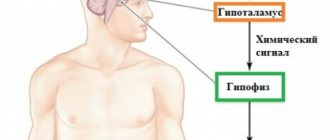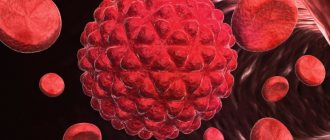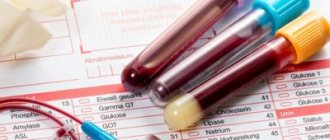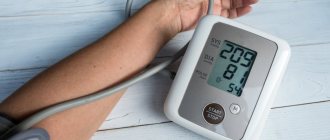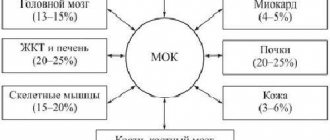K is the main cation of intracellular fluid, which contains 98% of the potassium of the whole body. The cation ensures osmolarity of the cytoplasm and creates conditions for biochemical reactions to occur in it. The entry of K into the cell through the plasma membrane is determined by many factors. Potassium channels provide passive permeability of the membrane for the cation, while the movement of K is determined by the magnitude of the electrical potential and the concentration gradient. Potassium channels can be in an open or closed state; the passive flow of potassium into the cell is determined precisely by the number of currently open channels. The high permeability of cell membranes for K, especially in a state of excitation, and “relative impermeability” for Na, leads to the emergence of a potential difference on the plasma membrane.
The stability of K content in the body is a consequence of balancing the processes of its intake and excretion. The intake of K from food is most important in the regulation of the total cation pool. An adult consumes 80–100 mmol K daily. From 85 to 90% of K taken in food is excreted by the kidneys. In the absence of K in food, 40–60 mmol/day is excreted in the urine for several days, after which the loss of K in the urine decreases to 10–20 mmol/day. 10–15% of K consumed with food is excreted through the gastrointestinal tract. This pathway of cation excretion may be enhanced in conditions of mineralocorticoid hypersecretion and renal failure. A significant amount of K can be released through the skin only in case of intense sweating.
Cells of the nervous and muscular systems quickly respond to a decrease in plasma K levels, which explains the early appearance of symptoms - muscle hypotension, weakness and asthenia, weakened reflexes. Some cases of hypokalemia lead to symptoms of paralysis and even rhabdomyolysis. Severe hypokalemia is accompanied by disturbances in conduction and rhythm of cardiac activity, which is reflected in the ECG (decreased wave amplitude, T wave inversion, widening of the S-T interval and the appearance of a U wave). With chronic K deficiency, the size of the heart increases, rhythm disturbances occur, and with a sharp decrease in the level of K in the plasma, cardiac arrest in systole is possible.
Symptoms of hyperkalemia depend on the rate of increase in the cation content in the plasma and are associated with changes in the membrane potential of neurons and muscle cells. Neuromuscular symptoms of hyperkalemia are expressed in paresthesia, and in more severe cases - in ascending paralysis of the limbs. The severity of cardiac symptoms depends on the degree of increase in plasma K - from minimal ECG changes to serious rhythm and conduction disturbances (transverse block and ventricular fibrillation). When the K concentration is above 6 mmol/l, as a rule, ECG changes are detected (sharpening of the T wave, lengthening of the P wave and P-R interval, widening of the QRS complex, elevation or depression of the ST segment), which become more and more pronounced as hyperkalemia progresses. At a K level above 7 mmol/l, the development of cardiac arrhythmia with a fatal outcome was noted; at a K concentration above 10 mmol/l, the heart may stop in diastole. In the clinic, prolonged hyperkalemia is most often a consequence of chronic renal failure.
Causes of high potassium in the body
The cell charge is provided mainly by potassium ions
Potassium is one of the most commonly found macronutrients in the body; every living cell of the body carries dissolved potassium ions that help it maintain the electrical potential on its outer membrane necessary for functioning.
We can figuratively compare the role of potassium in the body to the “filling” of a battery, while the majority of ions should be contained in the intracellular fluid; according to various sources, about 97-98% of potassium is concentrated there. Potassium is normally contained in the blood in fairly small quantities - 3.51 - 5.1 mmol/l (data may vary depending on the laboratory method used).
Adrenal pathology may affect potassium levels
Pathologically high amounts of potassium can enter the blood for a number of reasons:
- After an extensive burn, fracture, injury, as well as after severe operations. In this case, massive damage to the body’s cells plays a direct role: they are destroyed and their contents, which contain large quantities of potassium, come out. The substance quickly enters the blood, so a laboratory test can detect an increase in potassium already a couple of hours after cell death.
- Malfunction of the kidneys. It is the kidneys that are responsible in the body for the removal of most electrolytes (“salts”); when their tissue is damaged by infection, an autoimmune or tumor process, the blood composition very quickly begins to suffer. If the kidneys are damaged, potassium levels can reach life-threatening levels.
- Lack of production of hormones from the adrenal cortex. The adrenal glands can also suffer from infection (bacterial or viral) or be affected or compressed by a tumor; in rare cases, potassium may be elevated due to Addison's disease.
- Diabetes of the first or second type, accompanied by deterioration of the condition - acidosis. This is most often observed with dangerously high blood sugar values; in this case, an increase in potassium reflects the severity of the pathological process.
- Impaired respiratory function of the lungs. It can be a consequence of acute or chronic bronchitis, pneumonia, chronic obstructive pulmonary disease (COPD) and many other conditions.
Diabetes mellitus is a possible cause of hyperkalemia
The most common causes of increased potassium include kidney disease and endocrinological disorders, as well as taking high doses of potassium in the form of medications, treatment with drugs that reduce the excretion of potassium from the body.
How to replenish potassium loss
Under normal conditions, when you do not suffer from kidney disease, hypertension, edema of various natures, you do not often engage in grueling training or heavy physical work with intense sweating, potassium from food is enough for you. Good sources of potassium include tea, natural coffee, cocoa powder, all nuts and sunflower seeds, and raisins. Instead of sodium salt, you can use preventive food salt containing potassium salts.
The daily intake of potassium for an adult ranges from 2 to 4 grams. For significant physical activity – up to 5 grams. In total, a woman’s body should contain approximately 225 g of potassium, and a man’s body should have 250 g.
A whole series of drugs has been developed to simultaneously restore the balance of potassium and magnesium. The drug “Potassium-magnesium aspartate” and others like it restore electrolyte balance, replenish potassium and magnesium reserves, and normalize metabolic processes. The drugs “Aspangin”, “Asparkad”, “Asparkam” have a similar effect.
If you are taking triazides diuretics or diuretic herbs, you should then replenish your potassium balance with the help of Asparkam and Panangin. If you take a diuretic and Asparkam together, this will protect you from potassium loss. One Asparkam tablet contains 14.3 mg of potassium. The Panangina tablet contains 36.2 mg.
The selection of drugs should be entrusted to a doctor, because their combinations and mutual influence, if chosen independently, can lead to an overdose of potassium and harmful consequences for the entire body.
Symptoms and signs of high potassium levels
Fading of the heart may accompany hyperkalemia
A high level of potassium in the body may not manifest itself for a long time until the concentration reaches numbers several times higher than normal values. The first signs of increased potassium, as a rule, are general malaise, weakness, dizziness and headaches. As the condition worsens, the following most often appear:
- Disturbances in the functioning of the heart - may be accompanied by a feeling of “freezing” in the chest, interruptions in heart rhythm, and insufficient heart rate even during exercise. At rest, severe bradycardia will be observed - a low number of heartbeats per minute - less than 50.
- Indigestion - the most pronounced is nausea and prolonged lack of appetite; in severe cases, periodic vomiting may occur.
- Unusual sensations in the muscles - lethargy, a feeling of constant weakness, tingling of the skin.
- Cramps or numbness of the limbs, facial muscles.
- Rapid breathing, severe shortness of breath even at rest.
- Fainting or attacks of dizziness.
Biological role
First, I’ll tell you why the body needs potassium, listing its beneficial properties.
- Participates in the regulation of water-salt metabolism along with sodium .
- Produces an alkalizing effect.
- Participates in muscle contraction, converting glucose into energy.
- Regulates blood pressure and heart rate.
- Promotes the removal of fluid, helps cope with swelling.
- Improves oxygen supply to the brain, warns against certain types of mental disorders.
- Prevents stroke.
- Helps get rid of toxins.
- Increases the elasticity of blood vessels, protecting them from the formation of plaques.
- Prevents the leaching of calcium from bone tissue.
- Supports the functions of magnesium, an essential mineral for the heart.
- Carries out protein synthesis.
Indications and preparation for potassium analysis
Arterial hypertension - indication for analysis
Indications for analysis are:
- Kidney pathology - glomerulonephritis, pyelonephritis, any conditions associated with decreased urine production;
- Endocrinological diseases - diabetes of the first and second types, Addison's disease, hypoaldosteronism;
- Disturbances in the functioning of the cardiovascular system - any types of arrhythmias, bradycardia, arterial hypertension;
- Conditions after major operations, injuries or burns;
- Tumor processes of any localization.
Potassium levels are needed to monitor the effectiveness of treatment
In addition, potassium levels must be monitored during treatment:
- Diuretics (diuretics);
- Non-steroidal anti-inflammatory drugs (painkillers);
- Cardiac glycosides;
- Medicines to lower blood pressure (captopril, enalapril, lisinopril and others).
Preparation for the analysis consists of following a diet - before the study, you must stop overeating on fatty foods, 8-9 hours before the test, you should stop eating, and you can drink water. 1-2 days before the study, intense physical activity and sports are excluded.
What are the dangers of high potassium levels?
Arrhythmias may be caused by hyperkalemia
High potassium levels primarily reduce impulse conduction at neuromuscular junctions and between individual muscle fibers. The human heart is a single muscle with four chambers, which works like a pump due to its contractions; with an increase in potassium levels, the contractile function of the heart begins to be inhibited very quickly, and with increasing concentration, muscle weakness increases.
The heart turns out to be unable to eject blood into the arteries with the necessary force and beats at the right time; its individual sections begin to contract rarely and randomly.
When potassium levels rise to extremely high levels, cardiac arrest or fibrillation may occur.
Factors causing falsely high potassium levels
Physical activity the day before the test can affect the result
The main reasons for inaccurate analysis results include:
- Severe physical strain, especially accompanied by muscle pain, 1-2 days before donating blood;
- Excessive fasting before analysis (more than 12-13 hours);
- Insufficient amount of water taken the day before the test - you need to drink at least 1.0-1.5 liters of liquid, depending on the season;
- Taking medications containing potassium shortly before donating blood (asparkam, panangin and others);
- Failure of medical personnel to comply with standards for blood collection and transportation.
Correction of potassium levels
Diet is also important in correcting hyperkalemia
Correction of potassium levels at elevated levels should begin with the abolition of potassium-containing drugs - vitamin complexes, dietary supplements and other drugs. If possible, you should also exclude foods that contain excess potassium: dried fruits, apples, spinach, pumpkin, legumes, bananas.
Further therapy is prescribed by the attending physician in accordance with laboratory test data and the patient’s condition. In cases where potassium in the blood is slightly increased, it may be sufficient to prescribe a special group of diuretic drugs (furosemide, mannitol), which stimulate the kidneys to excrete potassium more intensively. In case of severe disturbances in the functioning of the heart, intravenous administration of calcium supplements is most often prescribed; if the condition worsens, hemodialysis is performed.
Why is there a shortage?
If you are used to constantly adding salt to your food, this can lead to potassium neutralization. Even when you eat enough foods containing potassium, salty foods remove it from the body.
In case of heavy sweating during heavy physical exertion, it is necessary to replenish the reserves of the element.
Drinking alcohol, especially under stress, causes potassium levels to drop significantly.
If a person is forced to take hormonal or laxative medications, the doctor must prescribe complex medications with sufficient potassium. After diuretic medications, a deficiency of the mineral often occurs, so it is necessary to take potassium tablets as prescribed by the doctor.
Preventing high potassium levels
Balanced diet - prevention of electrolyte abnormalities
Normally, blood contains the main macroelements in stable proportions: potassium, sodium, magnesium and calcium in dissolved form. All these components are equally important for maintaining the functioning of internal organs; with an inadequate increase in any of them, a relative “deficiency” of the remaining components is observed, since the balance is disturbed. Prevention of elevated potassium levels consists of maintaining the entire electrolyte composition of the blood at the proper level; the following should be supplied to the body daily with food:
- Calcium - found in large quantities in dairy products, sesame, almonds, poppy seeds, rose hips, parsley.
- Magnesium - in bran, buckwheat, pine nuts, halva, peanuts, chickpeas, walnuts.
- Sodium - found in table salt.
- Potassium - in dried fruits and dried vegetables, legumes, wholemeal bread, soybeans, dried mushrooms, spinach and other greens.
How to make up for it
The champions in potassium content are the following products:
To compensate for the mineral deficiency, an adult needs to eat 100 grams of these delicacies per day.
In addition, the mineral is present in foods with a lower percentage of the daily value. These include:
- pistachios
- white beans
- raisin
- tomatoes
- almond
- potato
- bananas
- pumpkin
- oranges
- avocado
- lentils
- spinach
- Brussels sprouts
- pumpkin seeds
- Walnut
